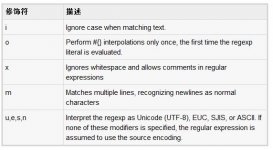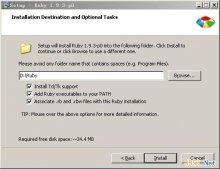用英语命名标识符。
|
1
2
3
4
5
6
7
8
|
# bad - identifier using non-ascii characters заплата = 1_000 # bad - identifier is a Bulgarian word, written with Latin letters (instead of Cyrillic) zaplata = 1_000 # good salary = 1_000 |
使用snake_case的形式给变量和方法命名。
|
1
2
3
4
5
6
7
8
9
10
11
12
13
14
15
16
17
18
19
20
21
|
# bad :'some symbol' :SomeSymbol :someSymbol someVar = 5 def someMethod ... end def SomeMethod ... end # good :some_symbol def some_method ... end |
Snake case: punctuation is removed and spaces are replaced by single underscores. Normally the letters share the same case (either UPPER_CASE_EMBEDDED_UNDERSCORE or lower_case_embedded_underscore) but the case can be mixed
使用CamelCase(駝峰式大小寫)的形式给类和模块命名。(保持使用缩略首字母大写的方式如HTTP,
RFC, XML)
|
1
2
3
4
5
6
7
8
9
10
11
12
13
14
15
16
17
18
19
20
21
|
# bad class Someclass ... end class Some_Class ... end class SomeXml ... end # good class SomeClass ... end class SomeXML ... end |
使用 snake_case 来命名文件, 例如 hello_world.rb。
以每个源文件中仅仅有单个 class/module 为目的。按照 class/module 来命名文件名,但是替换 CamelCase 为 snake_case。
使用SCREAMING_SNAKE_CASE给常量命名。
|
1
2
3
4
5
|
# badSomeConst = 5# goodSOME_CONST = 5 |
在表示判断的方法名(方法返回真或者假)的末尾添加一个问号(如Array#empty?)。
方法不返回一个布尔值,不应该以问号结尾。
可能会造成潜在“危险”的方法名(如修改 self或者 参数的方法,exit! (不是像 exit 执行完成项)等)应该在末尾添加一个感叹号如果这里存在一个该 危险 方法的安全版本。
|
1
2
3
4
5
6
7
8
9
10
11
12
13
14
15
16
17
18
19
20
|
# bad - there is not matching 'safe' method class Person def update! end end # good class Person def update end end # good class Person def update! end def update end end |
如果可能的话,根据危险方法(bang)来定义对应的安全方法(non-bang)。
|
1
2
3
4
5
6
7
8
9
10
11
12
13
14
15
|
class Array def flatten_once! res = [] each do |e| [*e].each { |f| res << f } end replace(res) end def flatten_once dup.flatten_once! endend |
当在短的块中使用 reduce 时,命名参数 |a, e| (accumulator, element)。
|
1
2
3
4
5
6
7
8
9
|
#Combines all elements of enum枚举 by applying a binary operation, specified by a block or a symbol that names a method or operator.# Sum some numbers(5..10).reduce(:+) #=> 45#reduce# Same using a block and inject(5..10).inject {|sum, n| sum + n } #=> 45 #inject注入# Multiply some numbers(5..10).reduce(1, :*) #=> 151200# Same using a block(5..10).inject(1) {|product, n| product * n } #=> 151200 |
在定义二元操作符时,把参数命名为 other (<< 与 [] 是这条规则的例外,因为它们的语义不同)。
|
1
2
3
|
def +(other) # body omittedend |
map 优先于 collect,find 优先于 detect,select 优先于 find_all,reduce 优先于inject,size 优先于 length。以上的规则并不绝定,如果使用后者能提高代码的可读性,那么尽管使用它们。有押韵的方法名(如 collect,detect,inject)继承于 SmallTalk 语言,它们在其它语言中并不是很通用。鼓励使用 select 而不是 find_all 是因为 select 与 reject 一同使用时很不错,并且它的名字具有很好的自解释性。
不要使用 count 作为 size 的替代。对于 Enumerable 的 Array 以外的对象将会迭代整个集合来
决定它的尺寸。
|
1
2
3
4
5
|
# badsome_hash.count# goodsome_hash.size |
倾向使用 flat_map 而不是 map + flatten 的组合。
这并不适用于深度大于 2 的数组,举个例子,如果 users.first.songs == ['a', ['b', 'c']] ,则使用 map + flatten 的组合,而不是使用 flat_map 。
flat_map 将数组变平坦一个层级,而 flatten 会将整个数组变平坦。
|
1
2
3
4
5
|
# badall_songs = users.map(&:songs).flatten.uniq# goodall_songs = users.flat_map(&:songs).uniq |
使用 reverse_each 代替 reverse.each。reverse_each 不会分配一个新数组并且这是好事。
|
1
2
3
4
5
|
# badarray.reverse.each { ... }# goodarray.reverse_each { ... } |




